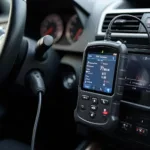OBD2 ports, the gateway to your car’s inner workings, have become a standard feature in modern vehicles. But when were OBD2 ports put in cars? Understanding the history of these diagnostic ports helps us appreciate their significance in vehicle maintenance and repair.
The History of OBD2 Ports: From Humble Beginnings to Standardized Diagnostics
The story of OBD2 (On-Board Diagnostics, second generation) begins in the 1970s, driven by growing concerns about air pollution. Early emissions control systems were rudimentary, and diagnosing problems was a challenge. California, a pioneer in environmental regulations, mandated early onboard diagnostic systems in the late 1970s. These initial systems, while basic, laid the groundwork for future OBD technology.
By the early 1990s, the California Air Resources Board (CARB) introduced OBD2, a standardized protocol for vehicle diagnostics. This standardization was a game-changer, providing a universal language for communicating with a vehicle’s computer. So, when were OBD2 ports put in cars nationwide? The answer is 1996. All vehicles sold in the United States after January 1, 1996, were required to be OBD2 compliant.
Why 1996? The Clean Air Act Amendments and the Standardization of OBD2
The 1990 Clean Air Act Amendments mandated OBD2 implementation across the United States. This landmark legislation aimed to reduce vehicle emissions nationwide. The standardization of OBD2 made it easier for mechanics to diagnose and repair emissions-related problems, ultimately contributing to cleaner air.
What Can an OBD2 Scanner Tell You?
OBD2 scanners, like the autophix om126 obdii obd2 code scanner, provide access to a wealth of information about your car’s performance. They can read diagnostic trouble codes (DTCs), which pinpoint specific malfunctions within the vehicle’s systems. Beyond emissions, OBD2 scanners can monitor parameters such as engine speed, coolant temperature, fuel system status, and more.
How OBD2 Benefits Car Owners and Mechanics
- Simplified Diagnostics: OBD2 provides a consistent method for identifying vehicle problems, making troubleshooting more efficient.
- Cost Savings: Early diagnosis can prevent minor issues from escalating into costly repairs.
- Improved Maintenance: Regular OBD2 scans can identify potential problems before they become noticeable, allowing for proactive maintenance.
- Empowerment for Car Owners: OBD2 scanners, especially mini elm327 obd2 ii bluetooth car auto diagnostic paired with a smartphone app, enable car owners to understand their vehicles better and take a more active role in their maintenance.
“OBD2 has revolutionized car repair. It’s like having a direct line to your car’s brain, allowing for precise and efficient diagnostics,” says John Davis, a seasoned automotive technician with over 20 years of experience.
OBD2 Beyond Cars: Applications in Other Vehicles
While commonly associated with cars, OBD2 technology has extended its reach to other types of vehicles. Trucks, buses, and even some motorcycles now incorporate OBD2 systems for diagnostics and emissions monitoring.
“The widespread adoption of OBD2 demonstrates its effectiveness in improving vehicle performance and reducing environmental impact,” adds Maria Sanchez, an automotive engineer specializing in emissions control technology. The increasing demand for obd2 to nmea 2000 integration in marine applications is another testament to its versatility.
The Future of OBD2: Connecting Cars to the Digital World
OBD2 continues to evolve. With the rise of connected cars and the Internet of Things (IoT), OBD2 ports are becoming a hub for data exchange. This opens up exciting possibilities for remote diagnostics, predictive maintenance, and integration with other smart devices. You might even consider looking into when were obd2 ports put in cars for more historical context. If you’re having issues with connecting, you might need an obd2 bluetooth driver.
In conclusion, the standardization of OBD2 ports in 1996 marked a pivotal moment in the automotive industry. It streamlined diagnostics, improved emissions control, and paved the way for the connected car technologies we see today. Understanding the history and functionality of OBD2 allows drivers and mechanics to harness its power for better vehicle maintenance and repair.
FAQ
-
What does OBD2 stand for?
- OBD2 stands for On-Board Diagnostics, second generation.
-
Where is the OBD2 port located in my car?
- The OBD2 port is typically located under the dashboard, often on the driver’s side.
-
Can I use any OBD2 scanner on my car?
- Most OBD2 scanners are compatible with all OBD2-compliant vehicles (1996 and newer in the US).
-
What is a DTC?
- A DTC (Diagnostic Trouble Code) is a code that indicates a specific malfunction within a vehicle’s system.
-
Do all cars have OBD2 ports?
- All cars sold in the US after January 1, 1996, are required to have OBD2 ports.
Need help with your car diagnostics? Contact us via WhatsApp: +1(641)206-8880, Email: [email protected] or visit us at 789 Elm Street, San Francisco, CA 94102, USA. Our 24/7 customer support team is ready to assist you.


